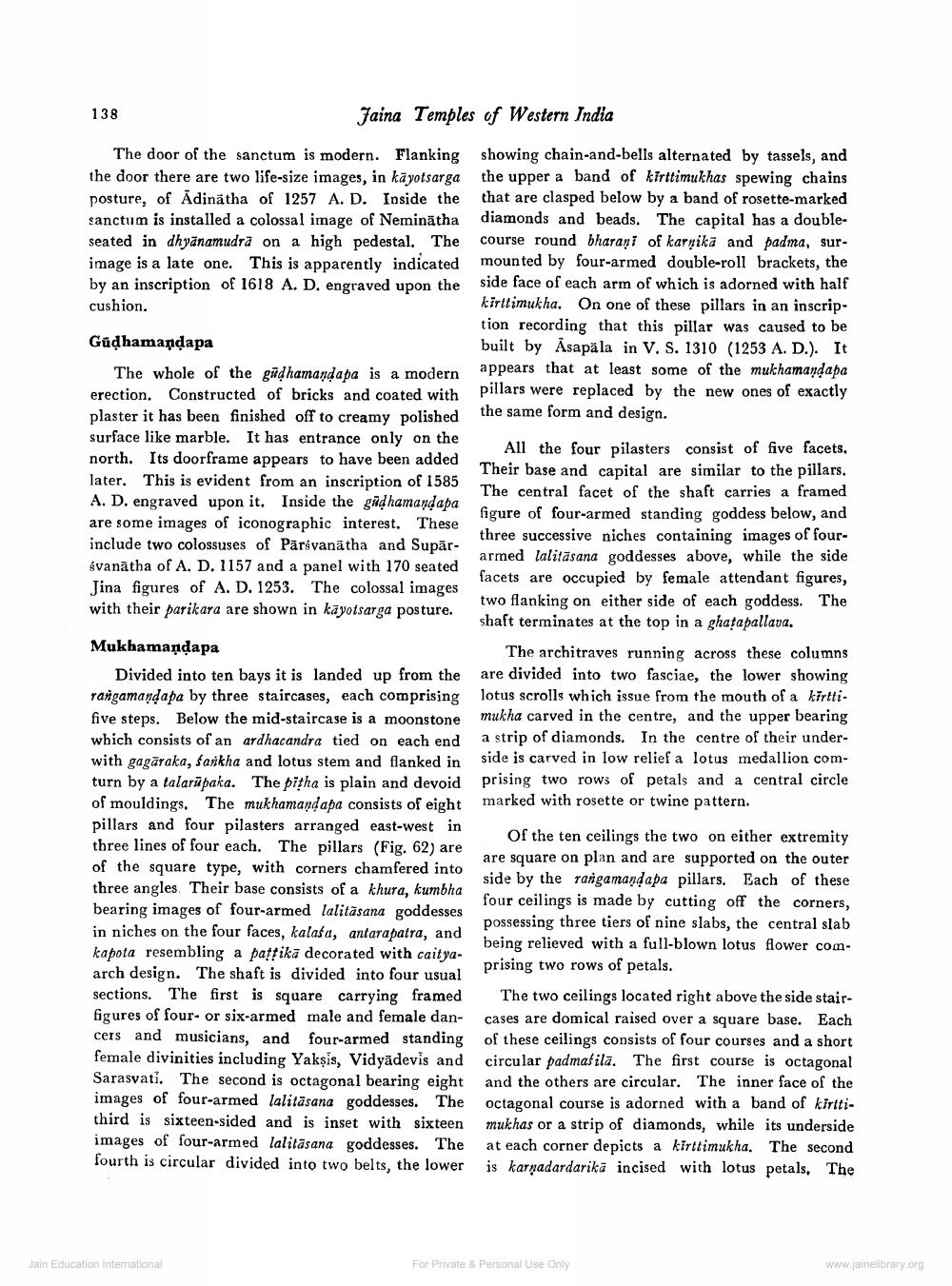________________
138
Jaina Temples of Western India
The door of the sanctum is modern. Flanking showing chain-and-bells alternated by tassels, and the door there are two life-size images, in kāyotsarga the upper a band of kirttimukhas spewing chains posture, of Ādinātha of 1257 A. D. Inside the that are clasped below by a band of rosette-marked sanctum is installed a colossal image of Neminātha diamonds and beads. The capital has a doubleseated in dhyānamudra on a high pedestal. The course round bharani of karnika and padma, surimage is a late one. This is apparently indicated mounted by four-armed double-roll brackets, the by an inscription of 1618 A. D. engraved upon the side face of each arm of which is adorned with half cushion.
kirttimukha. On one of these pillars in an inscrip
tion recording that this pillar was caused to be Güdhamandapa
built by Asapäla in V. S. 1310 (1253 A. D.). It The whole of the gūdhamanda pa is a modern appears that at least some of the mukhamandaba erection. Constructed of bricks and coated with pillars were replaced by the new ones of exactly plaster it has been finished off to creamy polished the same form and design. surface like marble. It has entrance only on the
All the four pilasters consist of five facets, north. Its doorframe appears to have been added
Their base and capital are similar to the pillars. later. This is evident from an inscription of 1585
The central facet of the shaft carries a framed A. D. engraved upon it. Inside the gūdhamandapa
figure of four-armed standing goddess below, and are some images of iconographic interest. These
three successive niches containing images of fourinclude two colossuses of Pārsvanātha and Supär
armed lalitäsana goddesses above, while the side svanatha of A. D. 1157 and a panel with 170 seated
facets are occupied by female attendant figures, Jina figures of A. D. 1253. The colossal images
two flanking on either side of each goddess. The with their parikara are shown in käyotsarga posture.
shaft terminates at the top in a ghatapallava. Mukhamaņdapa
The architraves running across these columns Divided into ten bays it is landed up from the are divided into two fasciae, the lower showing Tangamandapa by three staircases, each comprising lotus scrolls which issue from the mouth of a kirtti. five steps. Below the mid-staircase is a moonstone mukha carved in the centre, and the upper bearing which consists of an ardhacandra tied on each end a strip of diamonds. In the centre of their underwith gagāraka, fasikha and lotus stem and flanked in side is carved in low relief a lotus medallion comturn by a talarūpaka. The pitha is plain and devoid prising two rows of petals and a central circle of mouldings. The mukhamandapa consists of eight marked with rosette or twine pattern. pillars and four pilasters arranged east-west in
of the ten ceilings the two on either extremity three lines of four each. The pillars (Fig. 62) are
are square on plan and are supported on the outer of the square type, with corners chamfered into
side by the rangamandapa pillars. Each of these three angles. Their base consists of a khura, kumbha
four ceilings is made by cutting off the corners, bearing images of four-armed lalitāsana goddesses
possessing three tiers of nine slabs, the central slab in niches on the four faces, kalaša, antarapatra, and
being relieved with a full-blown lotus flower comkapota resembling a pattikā decorated with caityaarch design. The shaft is divided into four usual
prising two rows of petals. sections. The first is square carrying framed The two ceilings located right above the side stairfigures of four- or six-armed male and female dan- cases are domical raised over a square base. Each cers and musicians, and four-armed standing of these ceilings consists of four courses and a short female divinities including Yakşis, Vidyādevis and circular padmafila. The first course is octagonal Sarasvati. The second is octagonal bearing eight and the others are circular. The inner face of the images of four-armed lalitāsana goddesses. The octagonal course is adorned with a band of kirttithird is sixteen-sided and is inset with sixteen mukhas or a strip of diamonds, while its underside images of four-armed lalitasana goddesses. The at each corner depicts a kirttimukha. The second fourth is circular divided into two belts, the lower is karșadardarika incised with lotus petals, The
Jain Education International
For Private & Personal use only
www.jainelibrary.org




